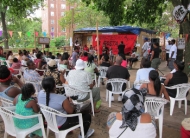Thomas Hirschhorn: Gramsci Monument, an experience
Date uploaded: March 5, 2014
For the final Visual Cultures lecture of the 2013/2014 series, the Royal College of Art is pleased to welcome Thomas Hirschhorn to give an insight into his Gramsci Monument project, commissioned by Dia Art Foundation 2013. Melanie Jordan, Senior Tutor in Sculpture at the Royal College of Art, London, will provide an introduction.
From July to September 15, 2013, Gramsci Monument was open seven days a week on the grounds of Forest Houses, a New York City Housing Authority development in the Morrisania neighborhood of the New York City borough of the Bronx.
The monument pays tribute to the Italian political theorist Antonio Gramsci (1891–1937), one of the most important Marxist thinkers in the 20th century, famous for his series of Prison Notebooks (1929–1937). Based on Hirschhorn's will "to establish a definition of monument, to provoke encounters, to create an event, and to think Gramsci today," Gramsci Monument is the fourth and last in Hirschhorn's series of "monuments." The series was dedicated to major writers and thinkers, which he initiated in 1999 with Spinoza Monument (Amsterdam, the Netherlands), followed by Deleuze Monument (Avignon, France, 2000) and Bataille Monument (Kassel for documenta XI, Germany, 2002).
Gramsci Monument was constructed as an outdoor pavilion divided into two wings, housing a museum, library, newspaper, computer room, radio station, bar, workshop, classroom and theatre. Each space was a part of civil culture; they were all built and run by the residents of Forest Houses.
It follows Hirschhorn's guidelines for "presence and production" in a work in a public space. The artist was based in the South Bronx, onsite, making work for the duration of the project. The monument also kept to Hirschhorn's commitment to materials that "do not intimidate;" it was constructed from low-grade two-by-fours, plywood, packing tape and tarpaulins.
Swiss-born artist Thomas Hirschhorn creates mixed-media installations, often using everyday materials such as cardboard, foil and duct tape, juxtaposed with found imagery such as violent scenes and pornography. Hirschhorn previously worked in a group of political graphic artists in 1980s Paris, which influenced his use of common materials as a political statement. With each exhibition, in museums, galleries, alternative spaces, as well as with specific works in public space, Thomas Hirschhorn asserts his commitment toward a non-exclusive public. Hirschhorn's work has been shown in numerous museums, galleries and group exhibitions including the Venice Biennale (1999); dOCUMENTA 11 (2002); the 27th Sao Paolo Biennale (2006); the 55th Carnegie International, Pittsburg (2008); the Swiss Pavilion at the 54th Venice Biennale (2011); La Triennale at Palais de Tokyo, Paris (2012); the 9th Shanghai Biennale (2012); and Gladstone Gallery New York (2012). Critical Laboratory: The Writings of Thomas Hirschhorn, edited by Lisa Lee and Hal Foster, has recently been published by MIT Press (October Books).
The lecture is free and open to the public and takes place Tuesday, 11th March, 6:30–8pm.
Booking is required, please email [email protected]
With 'Thomas Hirschhorn' as the subject line.
Royal College of Art
School of Fine Art
Gorvy Lecture Theatre
Dyson Building
1 Hester Road
London SW11 4AS

